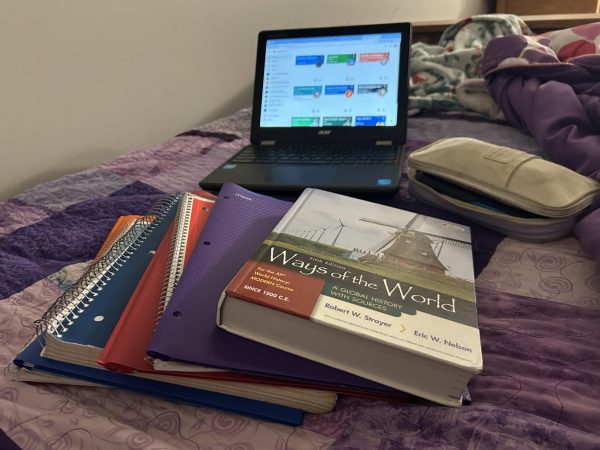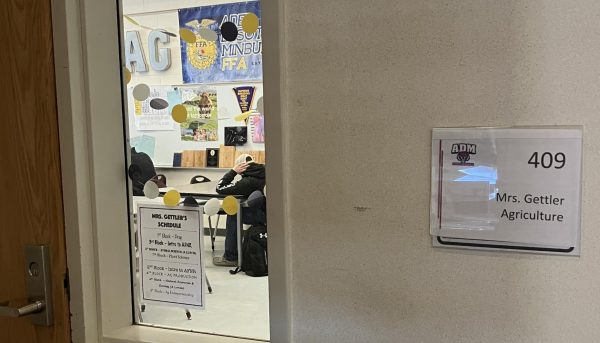Advanced Placement Courses at ADM
Eleven Advanced Placement (AP) courses are offered this year, with three of them having dual enrollment credit through DMACC. Many students have opted to take these more advanced, rigorous courses during the 2016-17 school year.
There are a lot of opinions about AP classes. Students, teachers and parents all feel differently about how AP classes benefit and hurt students.
Marissa Meadowcroft, a senior, is enrolled in one AP class, AP Language and Composition taught by Beth Basinger. Meadowcroft decided to take this class because she wanted a deeper English class and if she passes the AP exam at the end of the year she can earn college credit.
The AP exam is typically a two to three-hour exam, with the first part consisting of multiple choice questions, and the second part responses to questions that include essays, a solution to a problem or a spoken response. For AP Art students, they submit a profile of their work for review.
Meadowcroft also enjoys AP Language and Composition because it’s a very open class with a lot of discussion, which helps prepare her for college. This class is combined with Composition I and Composition II through DMACC.
Abbey Fouts was enrolled in AP World History, AP US History and is currently enrolled in AP Language and Composition. Fouts took these classes to take advantage of the 5.o scale for her GPA. Fouts says in her AP US History class she had a test every four days and a lot of writing, including DBQ’s, which she believes has helped her prepare for college.
Fouts has recently begun thinking about majoring in English in college, so her decision to take AP Language and Composition is helping her prepare for that possibility. One opinion Fouts has about the teaching of AP classes is that teachers need to prepare their students more for the final exam in the spring. She believes if you are passionate about the topic of the class, it is definitely something you should sign up for.
An AP class offered at ADM unlike any other is AP Studio Art. There are three forms of AP Art that are offered–AP Design, AP Drawing and AP 3D. In Design, students address two-dimensional design issues, including how to use the elements of art through any 2D media, including photography, drawing, fashion design, painting and graphic design. In Drawing, students focus on line quality, light and shade and composition. This portfolio can include mixed media, print-making and painting. 3D Design focuses on any three-dimensional approach. This includes ceramics, glass work, assemblage and architecture.
Cassidy Hammerberg, a senior, is enrolled in the 3D portion of AP Studio Art. She decided to take the class to grow her skills and challenge herself. She does this by working hard and coming up with her own assignments. The class especially challenges her creativity. Hammerberg enjoys AP Art, although she believes it is not for everyone. When asked if other students should take AP classes, she stated “Yes, if you’re willing to work for it, but if you’re not, don’t waste your time,” said Hammerberg. “If you won’t work for it, it will be a waste of your time and cause you a lot of unneeded stress.” Hammerberg said it is a more rigorous class, “but it’s a lot of fun, don’t cry.”
Chloe Spoonemore, a senior enrolled in two AP courses this year and one her junior year, decided to take these courses because she likes a challenge. Spoonemore states the workload of these classes are a lot different, sometimes it is very strenuous, other times the workload is low. The curriculum and information is more in depth, which she finds more interesting than other classes. Spoonemore would recommend taking AP courses, but only if you’re prepared for a lot of work. If you’re not, it’s going to be really difficult and you will easily fall behind.
All four of these students enjoyed their AP courses, but found that they had to be prepared to work hard and not get behind.
This past September, Kate Haas wrote an article for The Washington Post entitled “Why I regret letting my teen sign up for an AP course.” This article described her son’s AP student life, which included late nights of reading and filling out homework pages.
Within this article, she addressed a 2013 Stanford study that addressed the problems with AP courses. Haas stated within her article, “…because the AP experience differs widely from school to school, and is dependent primarily on the skill of individual teachers, it’s impossible to predict whether a student will benefit.” Students interviewed here at ADM felt they were benefiting from their AP course enrollment, which is a positive sign for ADM schools and teachers.
In the Stanford study, they also found not all colleges give credit for AP courses taken in high school. ADM students knew that, but still felt these classes were worth it because they were preparing them for college courses.
Within her article, Haas went on to describe a night she engaged with her son’s teacher. The teacher stated the whole point of this class was to gain test-taking skills and learn study strategies. Although students here take many tests, students also stated they enjoyed the discussion aspect of our AP courses.
Overall, ADM has a growing list of AP courses offered, including adding DMACC credit to go with AP credit.








